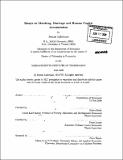Essays on matching, marriage and human capital accumulation
Author(s)
Lafortune, Jeanne
DownloadFull printable version (18.20Mb)
Other Contributors
Massachusetts Institute of Technology. Dept. of Economics.
Advisor
Esther Duflo and David Autor.
Terms of use
Metadata
Show full item recordAbstract
This thesis explores the link between human capital accumulation and the functioning of marriage markets. The first chapter studies the effect of marriage market conditions on pre-marital investment. After showing how a change in the sex ratio can alter incentives for investments, I test this prediction using exogenous variation in the marriage market sex ratio, brought about by immigration, exploiting the preference of second generation Americans for endogamous matches. I find that a worsening of marriage market conditions spurs higher pre-marital investments, measured by years of education, literacy and occupational choice. Overall, the results suggest that there are substantial returns to education in the marriage market, and that both men and women take these returns into account when making education decisions. The second chapter studies the role played by caste and other attributes in arranged marriages among middle class Indians. Using interview data from a sample of parents who placed matrimonial ads in a popular Bengali newspaper, we estimate preferences for each attribute. We then compute a set of stable matches and find it quite similar to the actual matches observed in the data, suggesting a relatively frictionless marriage market. There is a very strong preference for in-caste marriage but, because this preference is horizontal rather than vertical and because the groups are fairly balanced, in equilibrium, the cost of insisting on marrying within one's caste is small which allows castes to remain a persistent feature of this marriage market. Finally, the third chapter estimates the effect of marriage delay on fertility by exploiting state laws that restricted age of marriage in the first half of the 20th century. (cont.) These state laws strongly predict the age at first marriage for both males and females. Moreover, they also influence the age of one's spouse. Using these laws to instrument the age at first marriage for both spouses, I find that delaying marriage of a female by one year reduces fertility by 0.35. The effect of male's timing on fertility outcomes is smaller. Ignoring the effect that these laws have on one spouse's age would lead to an overestimate of the effect.
Description
Thesis (Ph. D.)--Massachusetts Institute of Technology, Dept. of Economics, 2008. Includes bibliographical references.
Date issued
2008Department
Massachusetts Institute of Technology. Department of EconomicsPublisher
Massachusetts Institute of Technology
Keywords
Economics.